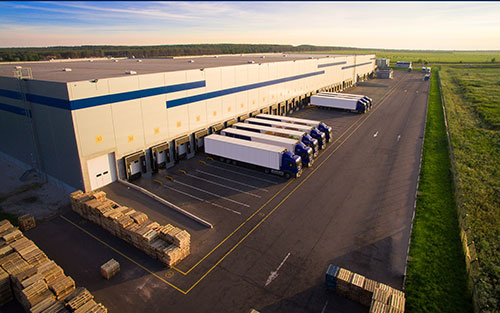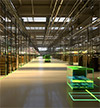Whether significant growth occurs in a short period of time or slower over years, companies experiencing growth, even at a small 3–5 percent compound annual growth rate (CAGR), will bump into capacity constraints. The company might be able to drive short-term efficiency of space, but at some point, these capacity constraints trigger the need for additional space options, whether that includes expansions, adding off-site storage, or relocation to a larger building.
Conversely, businesses that are experiencing a flattening or decline in their revenues will look for cost-takeout opportunities, closing facilities, or consolidations.
Mergers, acquisitions, and divestitures impact both of the above to the business. Companies making acquisitions of other businesses with operations in the same geographies may find cost-reduction synergies through the consolidation of some of those redundant operations. In some situations, consolidation may close multiple existing operations and merge them into a new, larger facility.
Changes in customer promise, particularly those requiring speed, will often require operations to be closer to the customer in order to meet demand. This can provide some cost savings opportunities if there is a shift from a higher-cost transport mode to a lower-cost transport mode.
At some point capacity constraints trigger the need for additional space options, whether that includes expansions, adding off-site storage, or relocation to a larger building. The phrase “eggs-in-one-basket” or companies operating their entire business or entire product line from one facility find themselves at risk of not being able to recover if something were to go wrong. Events such as a building fire, earthquake, flood, tornado, or other tragic event could impede the company’s ability to generate revenue.
Each of these is an example of how shifts in business strategy (growth, contraction, mergers and acquisitions, changes in customer promise, and risk mitigation) create changes in the company’s supply chain, which will often create changes in a company’s real estate portfolio.
Logistics Cost Components
For Industrial clients, there are a number of logistics cost components that influence site selection decisions: how many facilities, the role of each facility, size, and employee count. Most often, these logistics cost components include transportation costs, variable facility expenses (including labor, benefits, and maintenance), inventory carrying costs (capital captured by products sitting in inventory), fixed facility expenses (rent, utilities, insurance, etc.), and “other” related costs, which often include customer service, order management, and reverse logistics.
Typically, an organization’s total logistics spend breaks down to the following, on average:
- Transportation costs – 45 percent to 75 percent
- Variable facility expenses – 15 percent to 25 percent
- Inventory carrying costs – 12 percent to 16 percent
- Fixed facility expenses – 3 percent to 10 percent
- Other related costs – 7 percent to 10 percent
Businesses should focus on striking the right balance between acceptable logistics costs versus their speed and how each impacts revenue goals, market share, and customer expectations. Each one of these expenses should be considered a “trade-off” to determine how to minimize total logistics costs. For example, take an e-commerce retail company that has one location in California and generates $1 billion in revenue. The bulk of their logistics expenses are likely in transportation, as they will most often have to ship cross-country and upgrade from ground parcel to air depending on their customer promise.
Alternatively, a similar company located in the middle of the country may have lower variable, fixed, and inventory carry costs since they are located closer to customers. If this company were to increase the number of facilities and, consequently, their headcount, they may find that their overall logistics expenses may decline. Why, you ask? Often it takes only a 1 percent change in transportation expenses to yield, on average, and 8 to10 percent change in real estate. While variable and fixed facility costs increase incrementally, total logistics costs decrease.
Organizations also need to consider the ever-evolving question of logistics costs versus service. Businesses should focus on striking the right balance between acceptable logistics costs versus their speed and how each impacts revenue goals, market share, and customer expectations. Focus too much on the lowest logistics costs and your brand becomes unacceptable to the customer due to slow response time. Or, focus too much on highest service levels, and this begins to negatively impact profit margins. Being able to find the right balance between logistics costs and service is what organizations should focus on when making supply chain network decisions.
Once pins are on the map, so to speak, most supply chain costs are locked in. According to analysis from AMR Research, roughly 80 percent of a supply chain network’s costs are locked in once strategic and tactical network design decisions are made. Included in these decisions are an organization’s manufacturing and supplier networks, distribution networks, inventory placement, inventory levels, and top-level service policies. Meanwhile things like advanced planning and scheduling, ERP systems, and execution are operational decisions which make up the remaining 20 percent of the operational costs.
Finding the Optimal Location
So how do we get to the optimal locations, the right number of facilities, and acceptable service? The first analysis a firm should perform is a supply chain network design. Supply chain network design defines the supply configuration that provides the best balance of cost minimization, service excellence, risk mitigation, and complexity management based on customer requirements. As an end result of this analysis, organizations should be able to answer how many facilities are needed, where they are located, what the needed facility sizes are, how much talent is needed, and what the business case is.
In a perfect world, alignment between the best building, labor cost, and labor availability exists exactly where your organization needs it. In a perfect world, alignment between the best building, labor cost, and labor availability exists exactly where your organization needs it. Unfortunately, this is not always the case. For example, let’s take the same company described above and assume the results from the supply chain network design indicate Nashville, Tennessee, would be the optimal location for a primary or secondary facility. After performing a bit of investigating, this company finds that Nashville does not quite fit their labor needs and expands their search further within a specified radius a short distance away. We call this the “transportation zone of indifference,” or where labor and real estate logistics tradeoffs need to be made relative to transportation costs (the largest chunk of spending).
The next analysis that might be performed is a labor analysis, where talent availability and labor costs are balanced. Next, assume the most optimal market that is found that aligns the supply chain network design and labor analysis is in nearby Franklin, Tennessee. Here, there is another opportunity and added layer of complexity: economic incentives.
The number of jobs and investments that this organization is making may qualify for state and local incentives. This company might begin to work with the local economic development agencies to identify acceptable sites that meet their needs and negotiate with the local authorities for incentive packages.
The last component in the cycle is real estate. Does the existing site work, does the company need to make changes, or even does it need to build entirely from scratch? All are key decisions made at the final phase of the site analysis.
Finally, after assessing all the tradeoffs between transportation, labor, operating environment, incentives, and real estate, the organization decides on a site, ultimately balancing all of the logistics trade-offs.
Overall, the initial phase in the logistics analysis that drives site selection typically involves some form of supply chain network design, with depth trade-off depending on the specific needs. This is often followed by a labor analysis, incentives assessments, site selection, facility redesign and retrofits, or design, build, implementation of a new facility.

